Tehran Metro
The Tehran Metro (Persian: مترو تهران, romanized: Metro-ye Tehrān) is a rapid transit system serving Tehran, the capital of Iran. Tehran's is one of the busiest metros in the Middle East.[6] The system is owned and operated by Tehran Urban and Suburban Railway. It consists of 6 operational metro lines (and an additional commuter rail line), with construction under way on three lines including west extension of line 4, line 6 and north and east extension line 7.
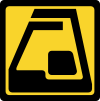 | |||
_(15025618305).jpg) A train at the Shahr-e-Rey Metro Station | |||
| Overview | |||
|---|---|---|---|
| Native name | مترو تهران | ||
| Locale | Tehran, Iran | ||
| Transit type | Rapid transit/metro (Lines 1-4, 6-7) Commuter rail (Line 5) | ||
| Number of lines | 7 active lines | ||
| Number of stations | 117 (metro) 128 (total)[1] | ||
| Daily ridership | 2.5 million[2] | ||
| Annual ridership | 820 million (2018)[3] | ||
| Website | Tehran Urban & Suburban Railway Co (TUSRC) > Home | ||
| Operation | |||
| Began operation | 1999 | ||
| Operator(s) | Tehran Urban and Suburban Railway Company (TUSRC) | ||
| Number of vehicles | 1,254[4] | ||
| Technical | |||
| System length | 149.1 km (92.6 mi) (metro) 97.7 km (60.7 mi) (commuter) 246.8 km (153.4 mi) (total)[5] | ||
| Track gauge | 1,435 mm (4 ft 8 1⁄2 in) standard gauge | ||
| |||
The Tehran Metro carries more than 3 million passengers a day.[7] In 2014, 815 million trips were made on Tehran Metro. As of 2019, the total system was 229 kilometers (142 mi) long,[8] 186 kilometers (116 mi) of which is metro-grade rail. It is planned to have a length of 430 kilometers (270 mi) with 9 lines once all construction is complete by 2025.[9]
On all days of the week, the Metro service runs from approximately 05:30 to 23:00.
The line uses standard gauge and is mostly underground. Ticket price is 1000 Iranian Toman for each journey (about US$0.25), regardless of the distance traveled, but using prepaid tickets costs much less. Seniors may travel for free on the metro. On all Tehran metro trains the first and half of the second carriages from each end are reserved for women. Women can still ride other cars freely.[10][11]
History


Initial plans for the metro system were laid in late 1960s but could not be executed until 1982 due to socio-political issues such as the Iranian Revolution and the Iran-Iraq war. In 1970 the Plan and Budget Organization and the Municipality of Tehran announced an international tender for construction of a metro in Tehran. The French company SOFRETU, affiliated with the state-owned Paris transportation authority RATP, won the tender and in the same year began to conduct preliminary studies on the project. In 1974 a final report with a so-called "street-metro" proposal was tendered. The street-metro system recommended a road network with a loop express way in the central area and two highways for new urban areas and an 8-line metro network which were complemented by bus network and taxi services. Geological surveys commenced in 1976. In 1978 construction on the line was started in northern Tehran by the French company, however this development was short-lived with the advent of the Iranian Revolution and Iran–Iraq War in 1979 and 1980 respectively. SOFRETU ceased operations in Iran in December 1980. On March 3, 1982, the Iranian Cabinet ministers formally announced the stop of Tehran Metro operations by the French company.

In 1985, the "Tehran Metro Execution Plan" was re-approved by the Majles, the Iranian Parliament, on the basis of legal project of "Amendment of Law of Establishment of Tehran Urban and suburban Railway Company" which had been founded on Farvardin 1364 (April 1985). This was a literal continuation of exactly the same project that had been laid out before the revolution. Work proceeded slowly due to the continuing Iran–Iraq War and often ground to a halt. By the summer of 1985, urban pressure from the rapidly urbanising population, and lack of developed public transport system prompted the work to be resumed in earnest. "Line 1" (From Blvd. Shahid Ayatollah Haghani to City of Rey) and its extension to Behesht-e-Zahra Cemetery was made a priority. "Line 2" (From Dardasht in Tehran Pars district to Sadeghiyeh Second Square) and an extending towards the City of Karaj and Mehrshahr district was also made a secondary priority. Studies were also made to establish the previously designed Lines 3 & 4. It was decided that an organisation by the name of the Metro Company should be established in order to handle the future development of the system.
Following this phase, the Metro Company was managed by Asghar Ebrahimi Asl for eleven years. During this time, hundreds of millions of dollars were spent on the system and the Metro Company was given government concessions for the exploitation of iron ore mines in Bandar Abbas (Hormuzgan Province), exploitation and sale of Moghan Diotomite mine in the Iranian region of Azarbaijan[12], export of refinery residues from Isfahan oil refinery as well as tar from Isfahan steel mill . The year after Asghar Ebrahimi Asl left the management of the Metro Company and Mohsen Hashemi succeeded him, the first line of the Tehran Metro was launched between Tehran and Karaj.
On 7 March 1999, an overland Tehran-Karaj express electric train started a limited service of 31.4 km (19.5 mi) between Azadi Square (Tehran) and Malard (Karaj) calling at one intermediate station at Vardavard. The line was constructed by the Chinese company NORINCO.
Line 5 of the Tehran metro began operating in 1999 and was Iran's first metro system.
From 2000 onwards, commercial operation began on Lines 1 and 2. The wagons on these lines are provided by CRV via CNTIC. The railway tracks and points on these lines are provided by the Austrian company Voestalpine.
The Metro uses equipment manufactured by a wide range of international companies: double-deck passenger cars for the Tehran-Karaj regional line are supplied by CRV (although some trains are from SEGC) via CNTIC and assembled by the Wagon Pars factory in Arak.
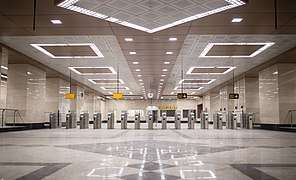
As of 2010 approximately $2 billion has been spent on the Metro project. The Tehran Metro transports about 2.5 million passengers daily[13] through its 7 operational lines (Lines 1,2,3,4,5,7,8). It also has additional one line under construction (Line 6), and an additional two lines in engineering phase. New 80 wagons have been added to the system in September 2012 to ease transportation and reduce rush-hour congestion. Iran is able to produce its need in wagons and trains independently.[14]
A 2.8-kilometre (1.7 mi) branch line of Line 4 began running to Mehrabad International Airport on 15 March 2016.[15] A 31-kilometre (19 mi) express line to Imam Khomeini International Airport was opened on August 2017.[16]
Lines
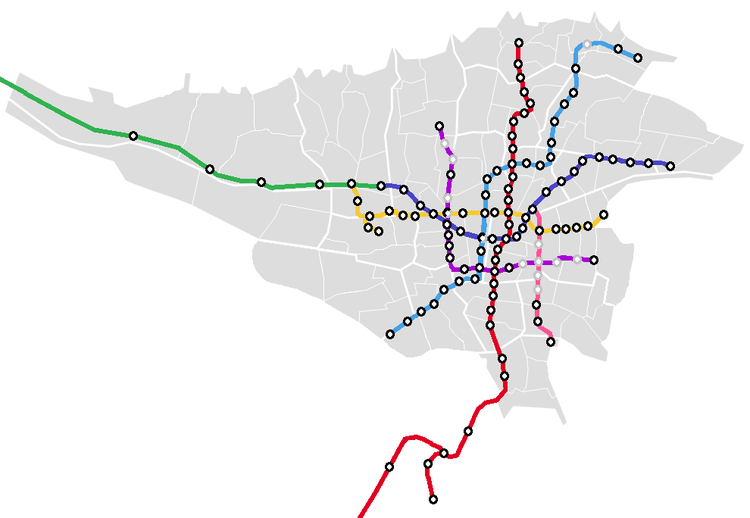
| Line | Opening[17] | Length | Stations[18] | Type |
|---|---|---|---|---|
| 1 | 2001 | 67.9 km (42.2 mi)[19] | 32[19][20] | Metro |
| 2 | 2000 | 24.6 km (15.3 mi)[21] | 22[20][21] | Metro |
| 3 | 2012 | 33.7 km (20.9 mi)[22][23] | 24[20][23] | Metro |
| 4 | 2008 | 23.0 km (14.3 mi)[24] | 22[24] | Metro |
| 5 | 1999 | 67.3 km (41.8 mi)[25] | 12[25][26] | Commuter rail |
| 6 | 2019 | 10.0 km (6.2 mi)[27] | 5 | Metro |
| 7 | 2017 | 20.3 km (12.6 mi)[28] | 11 | Metro |
| Metro Subtotal: | 149.1 km (93 mi) | 117 | ||
| Total: | 246.8 km (153 mi) | 128 | ||
| 8 | Planned | 34(planned) | Metro | |
| 9 | Planned | 39(planned) | Metro | |
| 10 | Planned | 35(planned) | Metro | |
| 11 | Planned | 17(planned) | Metro | |

Line 1

Line 1, coloured red on system maps, is 28.1 kilometers (17.5 mi) long, of which 14.9 km (9.3 mi) are underground (from Tajrish station to Shoush-Khayyam crossing) and the rest runs at surface level. There are 29 stations[19][20] along this line of which 22 stations are located underground and 7 above ground. As of 2018, the total capacity of line 1 is 650,000 passenger per day, with trains stopping at each station for 20 seconds. The trains are each made up of seven wagons, with a nominal capacity of 1,300 seated and standing passengers. The maximum speed of the trains is 80 km/h (50 mph) which is tempered to an average of 45 km/h (28 mph) due to stoppages at stations along the route.
Line 1 runs mostly north–south. A 4.1 kilometers (2.5 mi), three station extension of the line from Mirdamad station to Qolhak station opened on May 20, 2009. The 4 kilometers (2.5 mi), four stations second phase of this extension from Qolhak station to Tajrish Square was completed in 2011. Construction was to be completed by March 2007 but faced major issues due to large boulders and rock bed in part of the tunnels as well as water drainage issues. It has also faced major financing issues as the government has refused to release funds earmarked for the project to the municipality.
Since August 2017, one of Line 1's stations, Darvazeh Dowlat is open 24 hours a day, in order to accommodate passengers traveling to and from Imam Khomeini Airport via Line 1.[29]
Line 1 connects Tehran to Imam Khomeini International Airport. Its first phase, to Shahr-e-Aftab station, opened in 2016, and the airport station opened in August 2017. It is the only metro line in Tehran that is completely open 24 hours a day (even if the frequency is only 80 minutes...), in order to accommodate passengers from late night and early morning flights (Line 1's Darvazeh Dowlat station is the only other metro station outside of Line 1 with that classification).[29] A third phase, which is currently under construction, will extend Line 1 to the satellite city of Parand and bring the total length of the line to 50 km (31 mi). Its 120 km (75 mi) per hour speeds classify it as an express subway line, the first of its kind on the Tehran Metro.[30]
Line 2

This line opened between Sadeghieh and Imam Khomeini in February 2000.[31] Line 2 is 26 kilometers (16 mi) long,[21] with 19.6 km (12.2 mi) underground and 2.4 kilometers (1.5 mi) elevated. There are 22 stations along the line,[20][21] of which Imam Khomeini Station was shared by Line 1. Line 2 is coloured blue on system maps and runs mostly east–west through the city.
The line was extended from Imam-Khomeini to Baharestan Metro Station in 2004, and to Shahid Madani, Sarsabz and Elm-o-Sanat University in March 2006 with the intermediate stations, Darvazeh Shemiran and Sabalan, opening in July 2006.[31] It was extended further from Elm-o-Sanat University to Tehran Pars in February 2009, and to Farhangsara in June 2010.[31] The extension phase to new east terminal is under construction.
Line 3

Line 3 travels from northeast to southwest. Line 3 is one of the most important lines as it connects southwest Tehran to northeast, crosses busy parts of the capital city, and can help to alleviate traffic problems.[32] About 7 kilometers (4.3 mi) of Line 3 became operational in December 2012, followed by 12 kilometers (7.5 mi) in April 2014,[33] and finally, the last section of the line which is 18 kilometers (11 mi) opened on September 22, 2015, increasing the length of the line to a total of 37 kilometers (23 mi),[22][23] and serving 15 stations[23] as of December 2015.
Line 4

The line is 22 km (14 mi) long with 18 stations.[24] which connects the western part of Tehran to eastern part. This line initially runs through Ekbatan (western Tehran) to Kolahdooz (eastern Tehran). The construction of a western extension to line 4 has been started in 2012 connecting Ekbatan to Chaharbagh Sq. This extension included 3 stations. A sub-line of this line connects Bimeh station to Mehrabad Airport. This sub-line has 2 stations at Terminal 1&2 and Terminal 4&6.
Section 1, from Ferdowsi Square to Darvazeh Shemiran, opened in April 2008. Section 2 from Darvazeh shemiran to Shohada Square opened in February 2009. On May 24, 2009, Section 3 from Ferdowsi Square to Enghelab Square opened. On July 23, 2012 two more stations were inaugurated, connecting line 4 with line 5.[34]
Currently there are 19 stations in operation on Line 4, coloured yellow on the system maps.[32][35]
Line 5

Line 5 is coloured green on system maps; it is a 43-kilometer-long (27 mi)[25] commuter rail line and has 11 stations.[25][26] Entering the area of Karaj with main stations at Karaj and Golshahr. It connects with the western end of Line 2 at Tehran (Sadeghiyeh) station, and with the western end of Line 4 at Eram-e Sabz Metro Station.
Line 6

This line is coloured pink on system maps; it is a 9-kilometer-long (5.6 mi)[25] with a first section from Shohada Square to Dowlat Abad were opened on April 7, 2019.[36] When completed this line is 9 km (5.6 mi) long with 3 stations as it connects southeast Tehran to northwest. A tunnel boring machine (TBM) is used to construct the tunnel. TBM is using earth pressure balanced method to pass safely through urban areas without considerable settlement.
Line 7

This line, similar to line 6, and in contrast with line 3, goes from northwest to southeast and was constructed with modern TBM machines. Its first phase, compromising of 18 km (11 mi) of line and 7 stations were opened in June 2017.[37] This line have 22 km (14 mi) with 10 station right now.
Future Plans
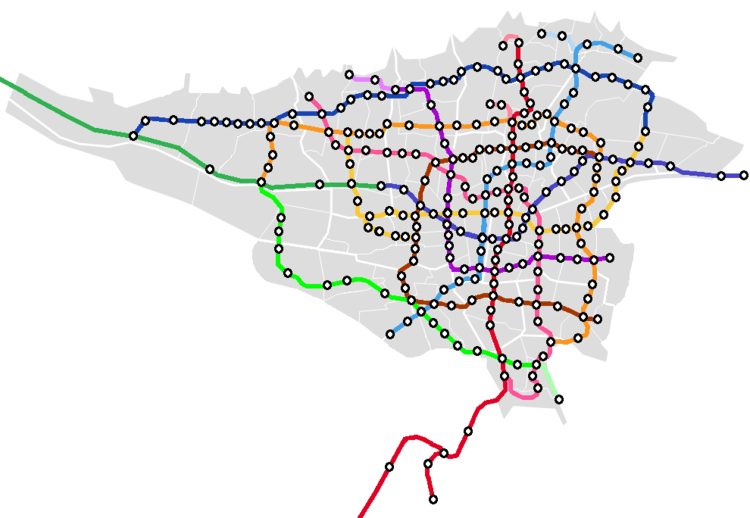
Line 8
Line 9
Line 10
Line 11
Expansions of the current 7 Lines
Line 1 Northern Extension and Branch Extension
Line 2 Eastern Extension
Line 3 Branch
Line 4 Eastern and Western Extension
Line 4 Airport Branch's Eastern Extension
Line 6 Southern Extension
Line 7 Northwestern Extension
LRT Lines
3 LRT (Tram) lines are proposed along with the Metro lines.
Express Commuter Railway
3 other commuter Rail lines are planned along with Line 5(Tehran-Karaj-Hashtgerd Commuter Rail) bringing the total Metro Commuter Rails to 4 Lines .
Interchange stations
- 1- Darvazeh Shemiran; Lines 2 & 4
- 2- Shahid Beheshti; Lines 1 & 3
- 3- Darvazeh Dowlat; Lines 1 & 4
- 4- Imam Khomeini; Lines 1 & 2
- 5- Theatr-e Shahr; Lines 3 & 4
- 6- Shademan; Lines 2 & 4
- 7- (Tehran) Sadeghiyeh; Lines 2 & 5
- 8- Eram-e Sabz; Lines 4 & 5
- 9- Shahed - Bagher Shahr; Lines 1 & 1
- 10- Shahid Navvab-e Safavi; Lines 2 & 7
- 11- Mahdiyeh; Lines 3 & 7
- 12- Meydan-e Shohada; Lines 4 & 6
- 13- Meydan-e Mohammadiyeh; Lines 1 & 7
- 14- Imam Hossein ; Lines 2 & 6
- 15- Shohada-ye Haftom-e Tir; Lines 1 & 6 (operational on line 1, under construction on line 6)
- 16- Meydan-e Vali Asr; Lines 3 & 6 (operational on line 3, under construction on line 6)
- 17- Towhid; Lines 4 & 7 (operational on line 4, under construction on line 7)
- 18- Daneshgah-e Emam Ali; Lines 2 & 3 (operational on line 2, planned on line 3)
- 19- Daneshgah-e Tarbiat Modares; Lines 6 & 7 (under construction on line 6, operational on line 7)
- 20- Shohada-ye Hefdah-e Shahrivar; Lines 6 & 7 (under construction on line 6, under construction on line 7)
Network map

Safety
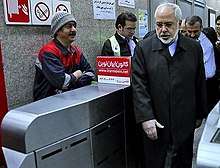
All routes have been equipped with automatic train protection (ATP), automatic train stop (ATS), centralized traffic control (CTC), and SCADA. More and more residents use the metro due to the improvement in the peak-hour headways, the opening of more stations and overall improvement with new escalators, elevators, and air-conditioning in the trains.
On 18 July 2007, a twenty square metres area immediately adjacent to the entrance of the Toupkhaneh metro station caved in. There were no casualties, but the station had to undergo numerous repairs. On 15 April 2012, safety walls of Mianrood River broke due to heavy rain in Tehran, and consequently, 300,000 cubic meters of water entered metro tunnel of Line 4. The two nearest stations were still under construction, so Metro operators had enough time to evacuate other stations from passengers. Nobody was killed, but water depth in the Habib-o-llah station, the deepest station on Line 4, was estimated to be near 18 meters. It took nearly two weeks to reopen the flooded stations which were previously in operation.[38]
Complaints
The Cultural Heritage Organization of Iran has complained that the vibrations caused by the Metro were having a significant and highly adverse effect on the Masoudieh Palace in the Baharestan neighbourhood of central Tehran.[39] The Cultural Heritage Organisation has also complained about vibrations near other historic sites such as the Golestan Palace and the National Museum of Iran. However, engineers and technical experts believe that it is the noise that induces the false sense of vibration and like many metro systems in large cities, no untoward impact is probable.
Another major complaint is the lack of a transfer station between lines 2 and 3, this has passengers having to transfer to line 4, travel a few stations along this highly congested line, and transfer again.
Tickets
Regular single table tickets[40]
You can only use the subway once with this ticket. This ticket costs 12,000 Rials. Of course, if you plan to take a round trip, you need to get two single tickets.
Suburban single table tickets[40]
This is the ticket from the 5th metro line that reaches Sadeghieh station from Karaj station. This ticket costs 12,000 Rials.
International Airport Single Ticket[40]
This ticket is used for the subway line of Imam Khomeini Airport. This ticket costs 90,000 Rials.
Electronic ticket[40]
You can use the subway as many times as you want by charging it. The cost of each of these e-cards is 30,000 Rials or 50,000 Rials and you can charge up to 500,000 Rials after purchase. You can charge your e-card using various booths and wall-mounted electronic charging devices at the bus and subway stations, either by cash or by bank credit card.
Tehran Metro Snapshot
 |
Tehran Metro | |||
|---|---|---|---|---|
| Stations | Length (km) | Ridership (in millions) | ||
| 128 | 245.8 | 721 | ||
| Ranking | ||||
| Iran | 1 | 1 | 1 | |
| Asia | 5 | 6 | 7 | |
| World | 12 | 12 | 14 | |
Gallery
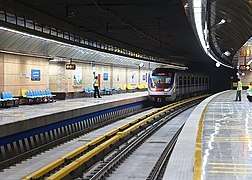 Tehran Metro Line 3 in 2016
Tehran Metro Line 3 in 2016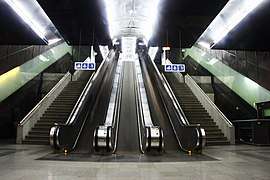 Escalators at Haghani Metro Station
Escalators at Haghani Metro Station Tehran Metro in 2012
Tehran Metro in 2012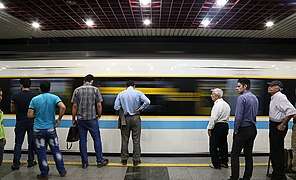 Passengers wait to board a train in 2018
Passengers wait to board a train in 2018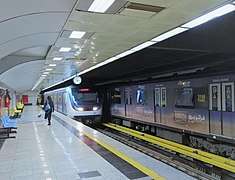 Samsung advertising in Tehran Metro
Samsung advertising in Tehran Metro Tehran Metro Line 6 under construction
Tehran Metro Line 6 under construction Tehran Metro Line 7 under construction
Tehran Metro Line 7 under construction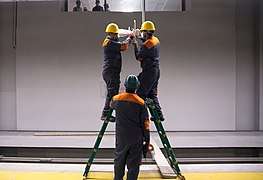 Tehran Metro Line 7 under construction
Tehran Metro Line 7 under construction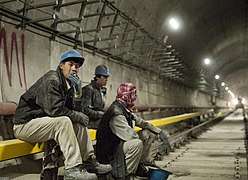 Asian employees of Tehran Metro at Milad Tower metro station
Asian employees of Tehran Metro at Milad Tower metro station
See also
References
- "کارنامه 28ماه متروی تهران". Archived from the original on 31 October 2017. Retrieved 29 October 2017.
- "روزانه ۲,۵ میلیون سفر توسط متروی تهران انجام میشود". Ana News Agency. Archived from the original on 12 August 2017. Retrieved 19 January 2020.
- "کارنامه 28ماه متروی تهران". Archived from the original on 12 August 2017. Retrieved 19 January 2020.
- امینی, اکرم. "هر ۳۴۰۰ مسافر یک واگن مترو". www.smtnews.ir. Archived from the original on 12 August 2017. Retrieved 15 July 2017.
- "آشنایی با مختصات خطوط مترو تهران". Archived from the original on 16 October 2017. Retrieved 29 October 2017.
- "Tehran Metro". Railway Technology. Retrieved 18 March 2020.
- "Tehran Metro head resigns in row with Ahmadinejad". Reuters. 5 March 2011. Archived from the original on 4 July 2013. Retrieved 5 March 2011.
- "شهرداری تهران". www.tehran.ir. Archived from the original on 18 March 2016. Retrieved 15 July 2017.
- "Tehran Metro, Iran". Railway-Technology.com. Archived from the original on 1 July 2014. Retrieved 29 June 2014.
- "خانه" (PDF). Tehran Metro (in Persian). Archived (PDF) from the original on 18 April 2016. Retrieved 6 January 2020 – via Google.
- Press TV. YouTube. Archived from the original on 18 July 2015. Retrieved 1 July 2015.
- "Tehran Subway". Mystery of Iran. Retrieved 18 March 2020.
- "Tehran Metro head Hashemi resigns". Trend. 5 March 2011. Archived from the original on 10 June 2013. Retrieved 1 July 2015.
- "70 واگن جدید مترو تهران ترخیص شد" [Tehran discharged 70 new subway cars] (in Persian). Archived from the original on 23 January 2016. Retrieved 11 December 2015.
- "Tehran metro serving Mehrabad Airport". Railway Gazette International. 18 March 2016. Archived from the original on 27 May 2016. Retrieved 26 April 2016.
- "UrbanRail.net > Iran > TEHRAN Metro". Archived from the original on 14 August 2017. Retrieved 14 August 2017.
- "About Metro - Metro History". Tehran Urban & Suburban Railway Operating Company. Archived from the original on 24 April 2014. Retrieved 23 April 2014.
- "Development of stations operating" (PDF). Tehran Urban & Suburban Railway Operating Company. 20 June 2011. Archived (PDF) from the original on 24 April 2014. Retrieved 23 April 2014.
- "خط ۱ مترو تهران و توسعه شمالي و جنوبي خط تا كهريزك". tehranmetrogroup.com (in Persian). Archived from the original on 8 December 2015. Retrieved 8 November 2015.
- "Stations". tehran.ir. Archived from the original on 25 August 2015. Retrieved 23 September 2015.
- "خط 2 متروي تهران و توسعه شرقي خط تا پايانه شرق". tehranmetrogroup.com (in Persian). Archived from the original on 8 December 2015. Retrieved 8 November 2015.
- "Rouhani inaugurates Middle East's longest subway line". Real Iran. 22 September 2015. Archived from the original on 23 September 2015. Retrieved 23 September 2015.
- "خط 3 مترو تهران". tehranmetrogroup.com (in Persian). Archived from the original on 25 October 2015. Retrieved 8 November 2015.
- "خط 4 مترو تهران". tehranmetrogroup.com (in Persian). Archived from the original on 4 March 2016. Retrieved 8 November 2015.
- "خط 5 مترو". tehranmetrogroup.com (in Persian). Archived from the original on 8 December 2015. Retrieved 8 November 2015.
- "Final profile Tehran Metro Station Line 5" (PDF). Tehran Urban & Suburban Railway Operating Company. Archived (PDF) from the original on 4 March 2016. Retrieved 5 September 2015.
- "Tehran Metro Line 6 Opens". Retrieved 7 April 2019.
- Barrow, Keith. "Tehran metro Line 7 inaugurated". Archived from the original on 15 June 2017. Retrieved 15 June 2017.
- "24/7 Subways". Financial Tribune. 9 August 2017. Retrieved 24 March 2020.
- "2nd Phase of Metro Line 8 Launched". Archived from the original on 14 August 2017. Retrieved 14 August 2017.
- Schwandl, Robert (2015). "Tehran". UrbanRail.net. Archived from the original on 1 October 2015. Retrieved 23 September 2015.
- "Lines 3 and 4 of Tehran Subway Rapidly Developing". Payvand Iran News. 15 December 2010. Archived from the original on 18 June 2013. Retrieved 23 April 2014.
- "12km section of Tehran Metro inaugurated". TehranTimes. 22 April 2014. Archived from the original on 17 March 2015. Retrieved 23 April 2014.
- "Two New Subway Stations Opened in West of Tehran". tehran.ir. Archived from the original on 10 January 2015. Retrieved 1 July 2015.
- "صفحه نخست". tehran.ir. Archived from the original on 22 July 2015. Retrieved 1 July 2015.
- "Tehran Metro Line 6 Opens". 7 April 2019. Archived from the original on 8 April 2019. Retrieved 8 April 2019.
- First parts of Tehran metro Line 7 inaugurated Archived 2017-06-15 at the Wayback Machine www.tehran.ir Official Tehran's website. June 2017
- "Tehran Successful Test in Crisis Management". tehran.ir. Retrieved 1 July 2015.
- "Masudieh Palace threatened by rumbling of Tehran Metro trains". payvand.com. Archived from the original on 13 November 2006. Retrieved 20 July 2006.
- "راهنمای مترو تهران" [introduction tehran metro]. karnaval (in Persian). Retrieved 12 November 2018.
External links
| Wikimedia Commons has media related to Tehran Metro. |
| Wikivoyage has a travel guide for Tehran. |
- Tehran Metro (official site) (in English)
- The Unofficial Homepage of Iranian Railways
- Video Clip of one of the Tehran Metro stations
- Network map (to scale)
- Tehran Metro Application for Android
- Tehran Metro Application for badaOS
- Tehran Metro Map PDF (in Persian)
- UrbanRail.Net – descriptions of all metro systems in the world, each with a schematic map showing all stations.
